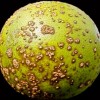 Nitrogen is the key component in mineral fertilizers applied to citrus groves. N has more influence on tree growth, appearance, and fruit production/quality than any other mineral element. Nitrogen affects the absorption and distribution of practically all other elements, and it is particularly important to the tree during flowering and fruit set. This 3-page fact sheet was written by Mongi Zekri and Tom Obreza, and published by the UF Department of Soil and Water Science, July 2013.
Nitrogen is the key component in mineral fertilizers applied to citrus groves. N has more influence on tree growth, appearance, and fruit production/quality than any other mineral element. Nitrogen affects the absorption and distribution of practically all other elements, and it is particularly important to the tree during flowering and fruit set. This 3-page fact sheet was written by Mongi Zekri and Tom Obreza, and published by the UF Department of Soil and Water Science, July 2013.
http://edis.ifas.ufl.edu/ss580
Tag: Mongi Zekri
Informacion para los propietarios: Cancro Citrico (PP298)
 El cancro cítrico es una enfermedad introducida en Florida y es muy perjudicial económicamente para la industria comercial. La enfermedad no está presente en todas las regiones tropicales y subtropicales productoras de cítricos donde el cancro cítrico puede ser problemático, por lo tanto, las restricciones para exportar fruta con cancro cítrico son muy estrictas. Esta enfermedad también concierne a los propietarios, no solo por sus efectos en la industria económica, sino también porque es altamente contagiosa y la mayoría de la fruta contagiada en un árbol muy afectado se cae de éste prematuramente. This 4-page fact sheet was written by M. M. Dewdney, P. D. Roberts, J. H. Graham, K. R. Chung, and M. Zekri, and published by the UF Department of Plant Pathology, January 2013.
El cancro cítrico es una enfermedad introducida en Florida y es muy perjudicial económicamente para la industria comercial. La enfermedad no está presente en todas las regiones tropicales y subtropicales productoras de cítricos donde el cancro cítrico puede ser problemático, por lo tanto, las restricciones para exportar fruta con cancro cítrico son muy estrictas. Esta enfermedad también concierne a los propietarios, no solo por sus efectos en la industria económica, sino también porque es altamente contagiosa y la mayoría de la fruta contagiada en un árbol muy afectado se cae de éste prematuramente. This 4-page fact sheet was written by M. M. Dewdney, P. D. Roberts, J. H. Graham, K. R. Chung, and M. Zekri, and published by the UF Department of Plant Pathology, January 2013.
http://edis.ifas.ufl.edu/pp298
Identificacion de los sintomas del cancro citrico y procedimientos de descontaminacion (PP214SP/PP138)
 El cancro cítrico es una seria enfermedad de los cítricos. La mayoría de los cultivos de cítricos son susceptibles, la toronja, la lima mejicana y algunas naranjas tempranas son las más susceptibles. Una infección severa puede causar defoliación, una muerte regresiva de la rama, una decadencia general del árbol, una caída prematura de la fruta, y manchas en la misma. Los árboles severamente infectados se vuelven débiles, improductivos y no rentables. This 5-page fact sheet was written by Mongi Zekri, Megan Dewdney, Jamie Burrow, and Pamela Roberts, and published by the UF Department of Plant Pathology, August 2012.
El cancro cítrico es una seria enfermedad de los cítricos. La mayoría de los cultivos de cítricos son susceptibles, la toronja, la lima mejicana y algunas naranjas tempranas son las más susceptibles. Una infección severa puede causar defoliación, una muerte regresiva de la rama, una decadencia general del árbol, una caída prematura de la fruta, y manchas en la misma. Los árboles severamente infectados se vuelven débiles, improductivos y no rentables. This 5-page fact sheet was written by Mongi Zekri, Megan Dewdney, Jamie Burrow, and Pamela Roberts, and published by the UF Department of Plant Pathology, August 2012.
http://edis.ifas.ufl.edu/pp138
Field Identification of Citrus Canker Symptoms and Decontamination Procedures (PP214/PP136)

Citrus canker, caused by the bacterial pathogen Xanthomonas citri subsp. citri, is a serious disease of citrus. The disease causes necrotic dieback, general tree decline, premature fruit drop, and fruit blemishes. Severely infected trees become weak, unproductive, and unprofitable. Learn how to identify citrus canker and proper procedures for decontamination with this 5-page fact sheet written by Mongi Zekri, Megan Dewdney, Jamie Yates, and Pamela Roberts, and published by the UF Department of Plant Pathology, July 2011.
http://edis.ifas.ufl.edu/pp136
PP194/PP116 Homeowner Fact Sheet: Citrus Canker
Revised! PP194, a 4-page illustrated fact sheet by M.M. Dewdney, P.D. Roberts, J.H. Graham, K.R. Chung, and M. Zekri, informs homeowners about this serious disease of citrus, its history, symptoms, spread, and control strategies. Published by the UF Department of Plant Pathology, October 2009.
http://edis.ifas.ufl.edu/PP116
SL-265/SS487 Dealing with Iron and Other Micro-Irrigation Plugging Problems
SL-265, an 8-page illustrated fact sheet by Tom Obreza, Ed Hanlon, and Mongi Zekri, describes problems with emitter plugging and discusses management strategies to overcome and correct causes of plugging in micro-irrigation systems. This publication focuses, in particular, on iron scaling, documenting recent successes in treating this common problem in Florida. Includes references. Published by the UF Department of Soil and Water Science, August 2008.
http://edis.ifas.ufl.edu/SS487